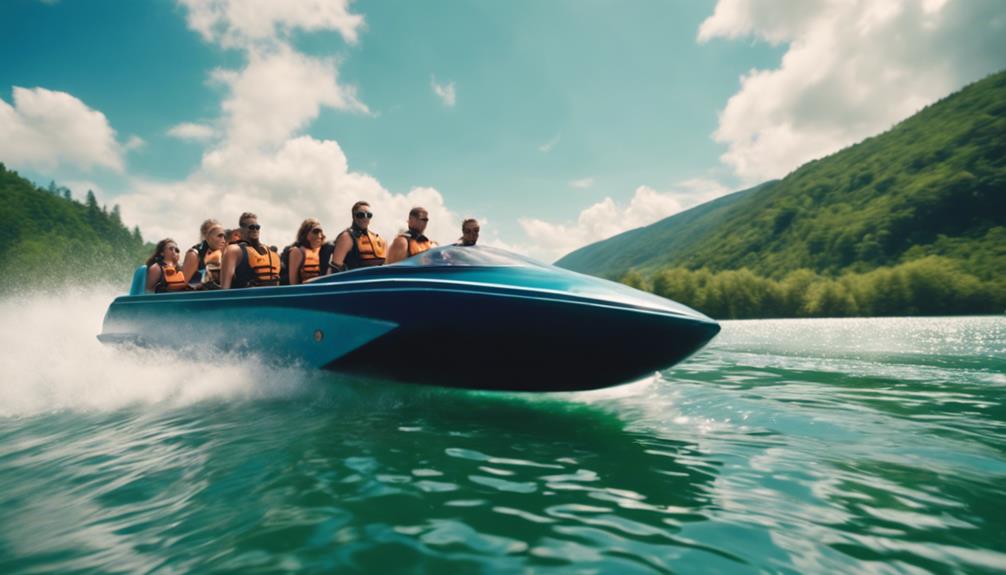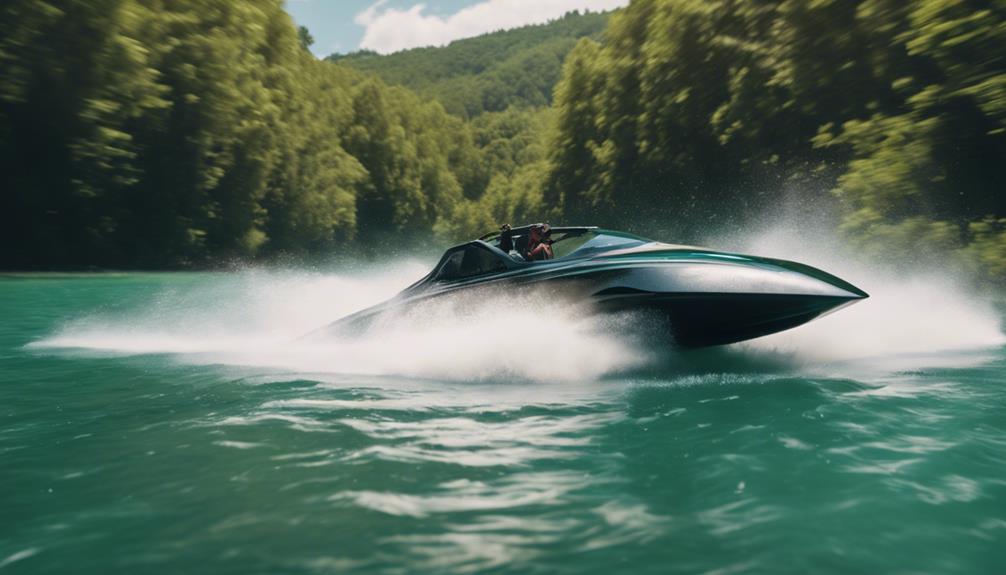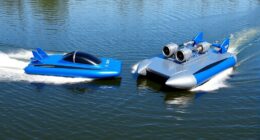The jet boat was invented in the mid-1950s by Sir William Hamilton in New Zealand. After 25 years of research, he launched the first successful model in 1953, revolutionizing shallow water navigation. This innovative design allowed boats to operate in water as shallow as 3 inches. By 1959, Hamilton had partnered with Buehler to manufacture jet boats in the U.S., leading to the creation of the Buehler Turbocraft. This significant advancement in technology has shaped water navigation and outdoor recreation ever since. If you're curious about the jet boat's evolution and impact, there's much more to explore!
Key Takeaways
- Jet boats were invented in New Zealand by Sir William Hamilton in the mid-1950s.
- The first successful jet boat was launched in 1953 after 25 years of research.
- Hamilton's invention enabled navigation in extremely shallow waters, as shallow as 3 inches.
- In 1959, Hamilton partnered with Buehler to manufacture jet boats in the U.S.
Origin of Jet Boats
The origin of jet boats traces back to the mid-1950s when Sir William Hamilton invented a revolutionary propulsion system in New Zealand, designed specifically for traversing shallow rivers. His groundbreaking work in jet propulsion allowed the modern jet boat to operate in waters as shallow as 7.5 cm (3 inches), something traditional propeller-driven boats couldn't manage. After 25 years of dedicated research, Hamilton launched the first successful jet boat in 1953, marking a notable advancement in boating technology.
This innovative design notably transformed marine navigation, enabling boats to access areas previously deemed unreachable. The unique water jet propulsion unit distinguishes jet boats from their conventional counterparts, offering enhanced maneuverability and speed.
By 1959, Hamilton partnered with Buehler to manufacture jet boats in the U.S., leading to the introduction of the Buehler Turbocraft. This model quickly gained popularity in the 1960s and further established the jet boat's reputation.
Sir William Hamilton's contributions not only paved the way for modern jet boats but also opened up a new domain of possibilities for recreational boating and commercial navigation, allowing enthusiasts to explore rivers and lakes like never before.
Sir William Hamilton's Innovations

Sir William Hamilton's pioneering innovations in jet propulsion revolutionized how boats navigate shallow waters, setting a new standard in marine engineering. In the mid-1950s, he developed the modern jet boat concept specifically for New Zealand's shallow rivers. The first successful jet boat, which you might find fascinating, operated upriver in 1953, showcasing a significant advancement in boating technology.
Hamilton's innovative jet unit utilized a Ford engine paired with a bevel gear-operated pump. This unique propulsion system allowed boats to run in as little as 3 inches of water, making it possible to access areas previously deemed unreachable. You can appreciate how this technology opened up new opportunities for exploration and transportation in challenging terrains.
Further advancements came with the Hamilton 400 Series, developed from 1978 and commissioned in 1981. These innovations not only enhanced jet boat performance but also laid the groundwork for modern high-speed commercial crafts and recreational boating.
Sir William Hamilton's contributions have undeniably shaped the future of marine navigation, proving that with the right innovations, even the most challenging conditions can be navigated efficiently.
Early Development and Designs
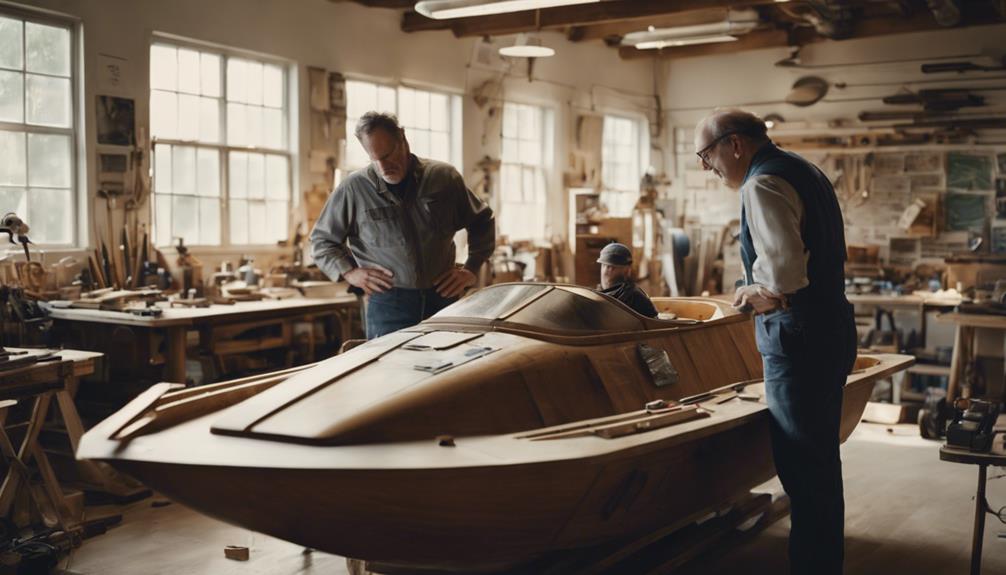
You'll find that Sir William Hamilton's innovations laid the groundwork for early jet boat designs, transforming marine propulsion.
His adaptations of existing jet unit concepts made it possible to navigate shallow waters efficiently.
As you explore the evolution of these designs, you'll see how each iteration improved performance and functionality.
Sir William Hamilton's Innovations
Innovative designs by William Hamilton revolutionized jet boat technology in the mid-1950s, enabling efficient navigation in shallow waters. His pioneering work introduced a propulsion system that utilized water jets, making it possible for jet boats to traverse rivers that were previously inaccessible. In 1953, you'd witness the first successful operation of his jet boat, demonstrating the potential of jet propulsion in reaching remote areas of New Zealand.
Hamilton's innovations didn't stop there. He later developed the Hamilton 400 Series, which began construction in 1978 and was commissioned in 1981. This series showcased higher performance capabilities and reflected his commitment to advancing jet boat designs. By utilizing CAD/CAM technology, Hamilton could create jet units for boats ranging from 15 to 30 meters long, powered by diesel engines capable of producing up to 1,500 horsepower.
The efficiency of his jet propulsion systems surpassed conventional propeller systems, achieving speeds over 25 knots. Through these advancements, Sir William Hamilton laid the groundwork for modern jet boat technology, transforming how enthusiasts and professionals navigate waterways. Hamilton's legacy in jet boat innovation remains unparalleled, shaping the industry for years to come.
Evolution of Jet Design
Building on Hamilton's groundbreaking work, the evolution of jet boat design in the mid-20th century introduced a variety of enhancements that markedly improved performance and efficiency.
Early designs primarily utilized a Ford engine paired with a bevel gear-operated pump, enabling steering in as little as 3 inches of water. This innovation laid the foundation for more advanced systems.
As the years progressed, the Hamilton 400 Series emerged in 1981, showcasing significant improvements in jet propulsion technology for high-speed applications. The development of waterjet units using CAD/CAM technology allowed for better integration with diesel engines capable of producing up to 1,500 horsepower. This leap in design not only increased power but also enhanced maneuverability in shallow waters.
Continuous innovations in jet design led to increased efficiencies, making modern jet boats comparable to conventional propellers at speeds exceeding 25 knots. These advancements have transformed the way you experience water travel, offering you faster, more agile, and efficient options for steering various waterways.
The evolution of jet boat design has truly opened up new possibilities for adventure on the water.
Jet Boat Mechanics Explained

Understanding jet boat mechanics is essential for grasping how these remarkable vessels operate.
You'll find that water jet propulsion relies on drawing in water and converting it into thrust, while steering is managed through strategic nozzle adjustments.
This combination allows for impressive maneuverability, even in shallow waters.
Water Jet Propulsion Basics
Water jet propulsion systems power jet boats by drawing in water from beneath the hull and expelling it through a nozzle at the stern, creating the thrust needed for movement. This propulsion system relies on water passing through impellers and stators, which increase its velocity before ejection, allowing for efficient high-speed performance.
In modern jet boating, most boats operate with single-stage jets, designed for peak performance in various conditions. Older models may use multiple stages, enhancing their capabilities further.
One of the standout features of jet boats is their ability to navigate in extremely shallow waters, often as little as 7.5 cm (3 inches). This makes jet boating particularly suitable for exploring shallow rivers and tight spots where traditional boats would struggle.
While you won't delve into steering mechanisms just yet, understanding how the water jet propulsion system works lays the foundation for comprehending the overall operation of jet boats.
With the thrust generated by this system, you're set for an exhilarating experience on the water, whether you're racing or leisurely cruising through picturesque landscapes.
Steering and Control Mechanisms
Jet boats have a unique steering mechanism that allows you to maneuver with precision by adjusting the direction of the water jet nozzle. This innovative design lets you control the jetstream, making sharp turns and quick stops possible, especially during exciting jet boat tours.
The engine must be running for effective steering, as the thrust generated is essential for redirecting the jetstream.
Here are some key features of jet boat steering:
- Nozzle Adjustment: You can move the water jet nozzle for precise directional control.
- Reverse Thrust: A deflector lowers into the jetstream to slow down or reverse the boat, enhancing control.
- Single-Stage Jets: Modern jet boats utilize single-stage jets for efficient propulsion, making them agile.
With these mechanics, you'll find jet boats incredibly responsive, whether you're zipping through narrow passages or gliding over open waters. Understanding these steering mechanisms enhances your experience and safety on the water.
Cultural Impact of Jet Boats

Emerging in the 1960s, jet boats quickly became cultural icons, attracting the attention of influential figures and enchanting the public's imagination through film and recreational activities. Their cultural significance soared when Jacqueline Kennedy and President Eisenhower endorsed Buehler jet boats, showcasing their appeal among the elite.
The 1965 James Bond film 'Thunderball' featured a Buehler Turbocraft, further cementing jet boats as symbols of modern adventure and excitement.
Jet boats also played an essential role in shaping American outdoor recreation, influencing community gatherings centered around water sports. Over 50 individuals learned to water ski using these innovative vessels, highlighting their impact on family bonding and leisure activities during the 1960s. The popularity of jet boats encouraged a wave of enthusiasts keen to embrace the thrill of speed and agility on the water.
Moreover, even geopolitical interest surrounded jet boat technology, as seen in a 1960 diplomatic incident involving a planned gift to Nikita Khrushchev. This illustrates how jet boats transcended mere recreational vehicles, becoming integral to cultural narratives and national identity during a transformative era in American history.
Applications in Modern Times
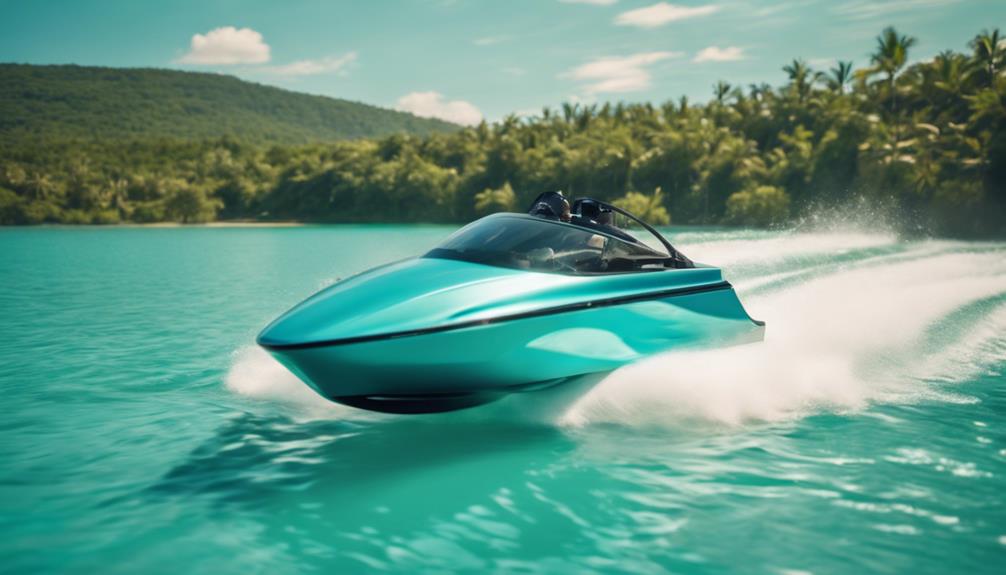
The impact of jet boats has evolved markedly since their cultural heyday, finding diverse applications in modern military, transportation, and adventure tourism sectors. You might be surprised to learn that jet boats are integral to military operations, like those on South Africa's Valour-class frigates and US Littoral Combat Ships, thanks to their speed and maneuverability.
In the transportation sector, these boats shine in high-speed passenger and car ferry services, steering through shallow waters with ease. They're also invaluable in rescue operations, providing rapid response capabilities in challenging environments.
Adventure tourism has embraced jet boats, allowing for thrilling river tours and jet sprint racing, bringing you closer to stunning marine life in some of the world's most scenic locations.
Here are some exciting applications of jet boats today:
- Military operations for swift troop deployment
- High-speed ferries for efficient passenger transport
- Rescue missions in remote or dangerous areas
Jet boats not only enhance boat operations but also redefine how you explore and interact with water.
Challenges and Limitations

Challenges arise with jet boats, as they can struggle with reduced fuel efficiency and performance issues when faced with blockages or mismatches between the engine and jet unit. These problems can hinder your experience on the water, making regular maintenance essential.
| Challenge | Explanation |
|---|---|
| Blockages | Debris in the intake grill can greatly impair performance. |
| Engine and Jet Unit Mismatch | Poor engine performance leads to inefficient fuel consumption. |
| Hull Resistance | Increased resistance at low speeds can limit maneuverability. |
| Maneuverability in Shallow Water | While jet boats excel here, hull strikes still pose risks. |
| Reverse Deflectors | These can enhance thrust without increasing speed, aiding control. |
While jet boats provide excellent maneuverability in shallow waters, they require careful handling. Hull resistance can affect how well you navigate at low speeds, and the absence of protruding components like propellers doesn't eliminate the risk of hull strikes. Being aware of these challenges will help you maintain your jet boat's performance and promote a safer, more enjoyable experience.
Future of Jet Boat Technology

Innovative advancements in jet boat technology are set to transform the industry, focusing on fuel efficiency and enhanced performance. As you look ahead, you'll notice several exciting trends shaping the future of jet boats.
- Improved jet unit designs will optimize water flow management, reducing disruptions and intake blockages.
- Lightweight composite materials and corrosion-resistant alloys will lead to more durable and lighter hull designs, ready to tackle any water condition.
- The rise of electric propulsion and hybrid systems won't only lessen environmental impact but also boost operational efficiency while delivering high performance.
These innovations promise to redefine what you can expect from jet boats. Research into hydrodynamics will likely yield breakthroughs that enable shallower draughts and improved high-speed performance in challenging environments.
This means that the jet boats of the future will be more efficient, safer, and ultimately more enjoyable for everyone who loves the thrill of steering the waters.
Frequently Asked Questions
Where Did Jet Boats Originate?
Jet boats originated in New Zealand, where Sir William Hamilton created the first successful model in the 1950s. His innovations allowed you to navigate shallow rivers more efficiently than traditional propeller-driven boats ever could.
Did NZ Invent the Jet Boat?
Yes, New Zealand did invent the jet boat. Sir William Hamilton's design revolutionized boating by allowing navigation in just 7.5 cm of water, showcasing innovation that's influenced watercraft technology worldwide since the mid-1950s.
What Is the History of Hamilton Waterjet?
The Hamilton waterjet's history showcases innovation in marine propulsion, starting in the 1950s with Sir William Hamilton's design for shallow rivers. Its advancements led to high-speed applications and improved efficiency, revolutionizing watercraft performance.
Who Invented the Jet Drive for Boats?
Imagine traversing a shallow river effortlessly. You can thank Sir William Hamilton, who invented the jet drive for boats in the mid-1950s, revolutionizing how vessels operate in low-water conditions with unmatched maneuverability and performance.
How Was the Invention of the Jet Boat Influenced by its Definition?
The definition of jet boat, as a watercraft propelled by a jet of water, directly influenced its invention. The concept of using a jet of water for propulsion led to the development of faster, more maneuverable boats, revolutionizing water transportation and water sports.
Conclusion
To sum up, the jet boat's journey from Sir William Hamilton's groundbreaking ideas to modern marvels is like a river carving its path through rock—a symbol of innovation and resilience.
You've explored its rich history, from early designs to its cultural impact and future potential.
As technology continues to evolve, jet boats will certainly navigate new waters, pushing boundaries and thrilling adventurers.
Embrace the excitement of this incredible vessel as it propels us into the future!



